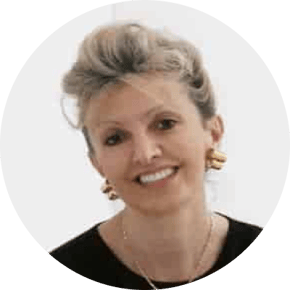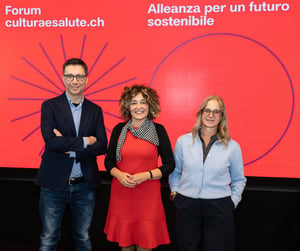One of founding aims of the strategic Culture and Health alliance project (presented in March 2020 and the result of a partnership between the IBSA Foundation and the City of Lugano Arts department) is to unearth the wealth of local skills and participants working on the relationship between the Culture and Health in centres for care, the arts and everyday life.
The 27th November saw the presentation and promotion of projects chosen from the "Call for Case studies" at Switzerland's first "Culture and Health, an alliance for a sustainable future" forum. These projects were carried out in the country, using innovative methods and established scientific findings.
The Canton of Ticino responded with great enthusiasm, indicating that there is a wealth of largely unknown institutions and professionals active in the culture as a health resource for major social challenges, especially ageing and degenerative diseases. There were three award winners and two honourable mentions.
"If we take art away from life, what do we have left?"
These are the words of Marcella, 86, one of the residents at the Lugano Social Institutes' homes for the elderly that hosted the Music in the Community. Art for Ages. A4A biennial (2015-17). This project is the result of doctoral research by Paolo Paolantonio of the Research and Development Department of the Italian Swiss Conservatory (CSI).
It provided ten weekly music sessions for residents with an average age of 84.6 years and Conservatory students who were trained by a multidisciplinary team of lecturers (in music, sociology and nursing). They sang together and played percussion instruments, with a repertoire ranging from classical music to popular and singer-songwriter songs, jazz and world music.
The study, conducted on two target groups (40 residents and 9 students), shows the relevance of music to the lives of elderly people who live in isolated settings and are beginning to doubt their cognitive abilities due to lack of stimuli. The results are encouraging, also on the students, especially due to their impact on reducing perceived stress, on motivation, increasing self-esteem, relational and social skills.
"I discovered music I didn't know... Russian and Spanish. You’re learning," says Pietro, aged 95. "If you hear a song or you sing it, you feel younger, you feel like you're alive... do you understand?" says 83-year-old Maria.
It also had a positive impact on the students' professional sphere, offering new ideas and making them question established patterns, as well as being energising, gratifying and stimulating affection through interaction. "This experience woke me up. It reminded me of the reason why I make music: other people," says Elena, 22, a guitarist.
This process was observed by applying the Perma model of Wellbeing (Seligman, 2011) to record positive emotions, engagement, relationships, meaning, results in terms of learning opportunities and interpersonal relationships.
Is the mind going dim? Art creates sparks
There were structured teams and individual artists. Patrizia Nalbach, a singer, cultural mediator and music therapist, has been lighting up "Scintille" ("Sparks") since 2014. This is a project for people with age-related cognitive impairment, including Alzheimer's disease and other forms of dementia.
It began in Lugano in partnership with the Social Institutes and the Museum of Art and is based on the theories of Gene Cohen (a U.S. psychiatrist who pioneered geriatric mental health, advocating for the impact of the arts on well-being), Ann Basting (Director of the Center on Age Community at the University of Wisconsin, USA, creator of the Time Slips method) and Paolo Cattaneo (on the perceptual phenomenology of musical language and its effects at a psychomotor, affective-emotional and cognitive level).
Sparks of visions, emotions, feelings, words and melodies. Music in culture centres, also involving carers, to unearth the deepest emotional memories. It is increasingly documented by neuroscience that singing calms anxieties and fears and helps cognitive and relational activities. Stimuli from the visual arts blend into a relationship of well-being, stimulated by listening, acceptance, and verbal and non-verbal expression. When viewing the works in the museum, people give voice to a story, sing and invent tales and songs. It involves visual and auditory stimuli, full-range vocality, improvisation, repetition, transcription, titling and comparison, harmonies and dissonance.
The project model has been extended from the LAC and MASI museums to other local culture institutions, involving interaction between public and private social welfare services to restore the dignity of individuals who have lost their role in society. As well as influencing perception, memory, emotion and learning, singing associated with viewing works of art has a positive effect on behaviour, including movement and relaxation, socialisation, recreation (play), gratification, contact with reality, psychological reinforcement and projection.
Other museums and galleries in the Canton of Ticino are now involved and poised to start an intergenerational project.
Allies in oncology. Art slays dragons.
For two years from December 2016, Roberta Pedrinis led a pilot project at the Novaggio Rehabilitation Clinic in Switzerland, funded by Helsinn Healthcare, to combine biomedical therapeutic rehabilitation pathways with art therapy (AT), on the hypothesis that they play an important role in stimulating a patient's inner resources.
It involved 170 people affected by neoplasms (102) or suffering from multifactorial chronic pain (68), with long-term therapies resulting in stress. In a group setting, with two weekly meetings to express themselves through painting and collage and from 3 to 8 meetings per participant, AT developed imagination and creativity, enabling people to reconnect with their forgotten strengths, mobilise self-care and self-generated resources to face their treatment pathway and respond better to the whole medical and scientific process.
There was a symbolic telling of life stories in a protected space, to express affective and emotional experiences that are difficult through words, to simulate creativity and the senses and to encourage people to talk about these experiences and the changes that occurred.
It involved strict evaluation. Self-assessment of the subjective experience, using a questionnaire with structured and open questions, was later cross-referenced with data collected by the Swiss National Association for Quality Development in Clinics and Hospitals (ANQ). A comparison of standardised clinical indicators at admission and discharge, measuring indices of effectiveness (Rehabilitation effectiveness (RES) starting with Functional Independence Measure (FIM) values), showed encouraging results for those taking part in AT during oncology treatment. Both their motor functioning and cognitive functioning showed a marked improvement compared to the control group.
This is explained by the stimulus offered by artistic expression, which encourages motivation and confidence in one's own potential in relation to the treatment pathway. Positive benefits can be seen in a relatively short time, regardless of gender, age and severity of the patient's clinical condition.
These projects have produced promising, award-winning results, with a potential increase in scale that could lead them from the pilot phase to inclusion in internal protocols.
There also were two honourable mentions for high-potential projects in progress.
One goes to Rita Pezzati, who is working with a SUPSI research group on non-pharmacological therapies for people with dementia in long-term care facilities, with a view to training staff and reduce the risk of burnout.
The second goes to the ASI (Swiss-Italian Autism Association), the Oltre Noi and San Gottardo Foundations and the Associazione Archivio Diversità Cognitiva, which joined forces to create a Neighbourhood Theatre in Breganzona, giving a platform to family carers of people who are neurodiverse or on the autism spectrum, together with professionals, and to raise public awareness of a world that is still unknown and mysterious to most people.
Art makes it possible to experience the inexpressible and to stimulate individual potential. In the field, in Switzerland, as in other territorial realities, ideals, skills, interdisciplinary dialogue, innovative methods based on scientific evidence, work on cohesion and Community Health as a resource for facing complex issues, deserve trust and funding.
Catterina Seia

